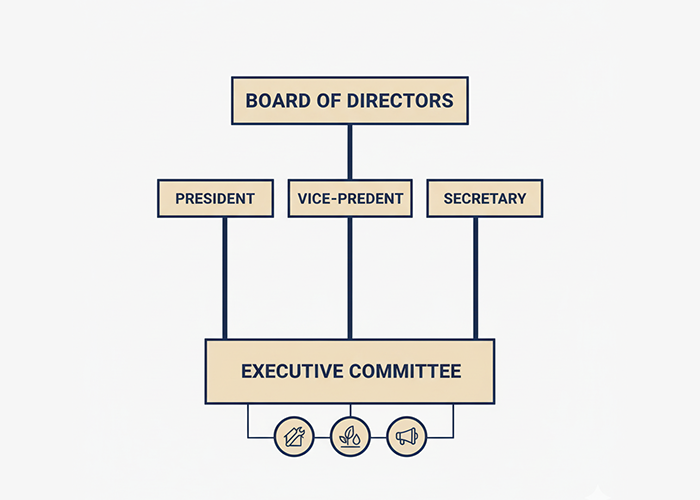HOA Executive Committee: Do HOAs Need One?

Some communities run smoothly with a full board of directors. Others move faster when a small group handles urgent items between meetings. The question is whether an HOA executive committee fits your community’s size, culture, and workload.
Browse By Category
Sign up for Our Newsletter
Some communities run smoothly with a full board of directors. Others move faster when a small group handles urgent items between meetings. The question is whether an HOA executive committee fits your community’s size, culture, and workload.
What is an HOA Executive Committee?
An HOA Executive Committee is a small group of directors, usually the officers, authorized to act on the board’s behalf between regular meetings. It does not replace the board. It exists to keep the association moving when time is tight.
This group is most helpful in communities with frequent vendor issues, fast-moving repairs, or heavy compliance needs. When the board meets monthly but decisions are needed weekly, an executive committee can bridge the gap.
How It Fits with the Board and Officers

Think of the board as the decision maker for big policy and budget choices. Officers carry out those decisions. The executive committee sits in between. It can approve items that fall within a limit the board sets and can direct management on small, urgent tasks.
A key point: the full board still owns the outcomes. The committee reports back, and its actions are recorded and ratified at the next meeting. That rhythm keeps authority clear and avoids confusion.
The Purpose of an Executive Committee
Boards create an executive committee to increase speed without losing oversight. The purpose of executive committee authority is not to take power from directors. It is to handle narrow, defined work so the community stays on schedule.
Common aims include faster approvals for small contracts, quick responses to safety issues, and timely communication during storms or building emergencies. When the scope stays tight, trust stays high.
Pros and Cons

An HOA executive committee can bring real value. It can shorten timelines for maintenance, reduce long email chains, and prevent meeting bottlenecks. It also gives management a clear point of contact when something cannot wait.
There are risks if boundaries are vague. If a committee starts making major policy calls or large purchases, other directors may feel sidelined. Homeowners can worry about transparency. Clear limits and regular reporting keep these concerns in check.
Common Responsibilities and Limits
Most governing documents allow a homeowners association executive committee to act on routine matters. Typical duties include approving small change orders, green-lighting emergency repairs within a dollar cap, or issuing short letters aligned with adopted policies.
Limits matter. The committee should not adopt the budget, change assessments, amend rules, or sign multi-year contracts. It should not decide on litigation strategy or impose fines beyond what the board already approved. When in doubt, send it to the full board.
How to Create One the Right Way

Start with your documents. Check your bylaws for authority to form committees, quorum rules, and notice standards. If the bylaws are silent, consult counsel and adopt a board resolution that spells out the structure and guardrails.
Define the basics in plain language. List who serves, how long they serve, what qualifies as an urgent item, and the spending cap. Note how meetings are called, how minutes are kept, and how actions are reported to the full board. The more specific the resolution, the easier it is to follow.
Safeguards that Build Trust
Transparency makes or breaks a committee. Post meeting notices if your state law or documents require open meetings for board committees. Keep brief minutes. Include each action in the next board agenda so the full board can ratify it.
Set a modest spending limit and revisit it yearly. Require two signatures for payments above a threshold. Ask the manager to track committee decisions in a simple log. These small habits prevent drift and protect everyone.
When an HOA Executive Committee Makes Sense

Some boards meet quarterly and rely on email in between. That pattern can leave projects stuck. An HOA executive committee helps in communities with active construction, aging infrastructure, or frequent weather events. It also suits large properties where daily operations generate many time-sensitive calls.
In smaller communities with light workloads, a committee may offer little benefit. If the board can meet monthly and respond promptly, you may not need another layer.
Practical Scenarios
Imagine a pipe bursts on a Sunday. Water is leaking, and a contractor can start right away if someone authorizes the work. The committee can approve the repair within the spending cap, protect the property, and report back at the board meeting.
Or consider a grant with a deadline that falls between meetings. The manager needs permission to submit the application that the board already endorsed in concept. The committee can give the green light, and the board can confirm it later.
Working with Management the Smart Way

Managers handle the day-to-day, but they need clear direction. A standing call between the manager and the committee chair can keep priorities aligned. If a request falls outside the scope, the manager places it on the next board agenda.
Provide a short decision matrix to your manager. For example, routine repairs under the cap go to the committee, policy changes go to the full board, and anything unclear gets flagged for discussion. Clarity reduces delays and mistakes.
Communication with Homeowners
Owners want to know who is making decisions. Tell them the board formed a committee, why it exists, and how limits work. Share the resolution summary in a newsletter and at the annual meeting. Post committee minutes if required.
If the committee acts on an urgent matter, provide a short update. Simple notes like these build confidence and reduce rumors.
What are the Alternatives?

If your board chooses not to create a committee, you still have options. Hold shorter, more frequent board meetings. Adopt a consent agenda for routine items. Delegate minor approvals to the community manager within a very small cap and require weekly reporting.
You can also form task-based committees that do not make decisions but prepare recommendations. A finance or maintenance committee can organize facts so the board decides faster during regular meetings.
Does Your Community Need One?
Use a simple test. Count how many decisions stalled in the last six months because the board could not meet in time. If the list is long, a HOA executive committee may help. If not, improve your meeting schedule and workflows instead.
The right choice depends on your documents, state law, and the culture of your board. What matters most is the clarity of roles and the habit of reporting back.
Efficiency for the HOA
An HOA executive committee can speed up routine work and reduce stress when it stays within clear limits. If you set tight guardrails and report every action, it can serve your owners well. If your workload is light, simpler options may suit you better.
Need help in managing your HOA community ? Let professional HOA managers help you out! Check out our online directory today for your area’s best HOA management companies!
Related Articles:
Trending Now
Related Article
Sign up for Our Monthly Newsletter
Sign up below for monthly updates on all HOA Resource















